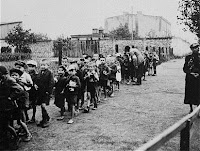 More
than a half century after the destruction of the Lodz ghetto and the
liberation of Auschwitz, fourteen-year-old Rywka Lipszyc's voice is
still strong and clear. Although several diaries from the Holocaust have
been published, Lipszyc's is important and unique, especially because
of her unwavering faith in God.
More
than a half century after the destruction of the Lodz ghetto and the
liberation of Auschwitz, fourteen-year-old Rywka Lipszyc's voice is
still strong and clear. Although several diaries from the Holocaust have
been published, Lipszyc's is important and unique, especially because
of her unwavering faith in God.Lipszyc kept her short diary from the fall of 1943 to the spring of 1944, when it ends abruptly midsentence, although we know she survived at least another year. By the time she started documenting her thoughts, Lipszyc had seen both parents die and had lost two younger siblings to deportation. Later her aunt, with whom she was living, also died, leaving behind a household of five girls, all under the age of twenty, to endure the privations of the ghetto.
When the cousins were deported to Auschwitz in the fall of 1944, Lipszyc was able to take her unfinished diary with her. In the remaining months of the war, the girls were transferred first to Christianstadt and finally to Bergen-Belsen. At the liberation, the two surviving cousins were told that Lipszyc would not live, even with medical care. Thus they reluctantly left her behind in the care of Allied doctors. Meanwhile, a doctor in the Red Army discovered Lipszyc's diary in a pile of prisoners' personal effects at Auschwitz; she picked up the little notebook took it back to Russia.
 The
diary remained with the doctor's possessions until it was discovered by
her granddaughter in 1995. The young woman, recognizing the historical
significance of notebook, turned it over to American scholars and
historians. After this remarkable journey, Lipszyc's private thoughts
are now, finally, available to the world, offering an unexpected
opportunity to learn more about the Lodz ghetto.
The
diary remained with the doctor's possessions until it was discovered by
her granddaughter in 1995. The young woman, recognizing the historical
significance of notebook, turned it over to American scholars and
historians. After this remarkable journey, Lipszyc's private thoughts
are now, finally, available to the world, offering an unexpected
opportunity to learn more about the Lodz ghetto. So often the words of young Holocaust victims focus on secular issues, on broken dreams, on the unfairness of their lot, on their growing hunger. And Lipszyc is, of course, no exception, as she grieves the loss of her family and the closing of her school. But she struggles especially with the dichotomies in her life: she is responsible for her little sister but is watched over by an older cousin; she wants to practice her faith but is forced to break God's commandments; she doesn't want to let go of hope but is compelled to face reality; she wants to be understood but also to be left alone.
 Even
if Lipszyc's diary were predictable, it would still be a significant
historical discovery. But this remarkable girl was not like her peers.
She astounds us with her keen observations of her neighbors and,
particularly, with her deep reliance on God. Unlike many Holocaust
diarists, she never turns her back on her religion; instead she embraces
the hardships "because as long as it hurts, I'm a human being. I can
feel--Otherwise it would be very bad. God! Thank you for your kindness
toward us!"
Even
if Lipszyc's diary were predictable, it would still be a significant
historical discovery. But this remarkable girl was not like her peers.
She astounds us with her keen observations of her neighbors and,
particularly, with her deep reliance on God. Unlike many Holocaust
diarists, she never turns her back on her religion; instead she embraces
the hardships "because as long as it hurts, I'm a human being. I can
feel--Otherwise it would be very bad. God! Thank you for your kindness
toward us!"The short diary is supplemented with fascinating supporting material. Readers will find annotations, discussions on the diary's authenticity and historical context, photographs, and even an essay from one of Lipszyc's surviving relatives.
Beautifully and sensitively translated, Rywka Lipszyc's diary provides an eloquent and surprising perspective on life, hope, and faith in one of the worst of the Jewish ghettos.
NOTE: photos are of the Lodz ghetto and are, as far as I can tell, in the public domain. Click images to see them full size.
Originally written for a September issue of Readerly magazine.
Published by HarperCollins / Harper, 2015
ISBN-13: 9780062389688
Source: Review (see review policy)
Copyright © cbl for Beth Fish Reads, all rights reserved (see review policy)
How have I missed this book?! It sounds devastating and important.
ReplyDeleteI will be reading this book.Thankyou for discovering another important gem for me,
ReplyDeletei suspect this is not an easy read ... thank you as always for the review/recco
ReplyDeleteI am adding this to my TBR list!
ReplyDeleteI have reserved this at our library - though it hasn't come it yet. Thank you for an insightful review of the book.
ReplyDelete